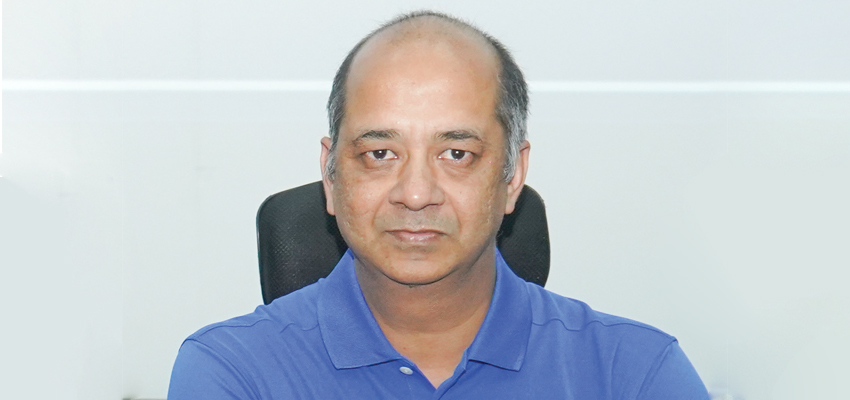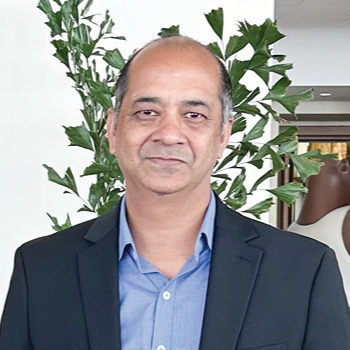Mastering Change with Courage

From solving engineering puzzles to steering digital transformation at scale, Himanshu Swami has built a career on clarity, courage and conviction. As Vice President at Mastek, he has led complex change programmes, empowered diverse teams, and championed soft skills as the real power skills. In this candid conversation with Corporate Citizen, he shares lessons from his journey — why leadership is more about empathy than authority, and how courage remains the constant in mastering change
From the structured corridors of engineering to the high-stakes arena of corporate leadership, Himanshu Swami, Vice President - Salesforce at Mastek, has charted a path few could imagine. With over 18 years of experience spanning healthcare, automotive, retail, telecom, higher education, technology and manufacturing, he has built a reputation not just for selling strategy and driving complex digital transformations, but for cultivating talent, shaping culture, and merging data-driven precision with human intuition. In an era dominated by AI and relentless disruption, his approach to leadership is at once timeless and forward thinking—a masterclass in clarity, courage and empathy.
His journey began in the disciplined world of engineering. “Engineering taught me structured problem-solving, careful navigation of constraints, and the pursuit of precision,” he reflects. Amid this rigour, he felt the itch to push beyond conventional boundaries. A vivid memory lingers: watching a cricket match, captivated, a thought struck him - why play the full 50 overs when taking calculated risks could achieve victory faster? That moment of curiosity signalled the start of his journey beyond purely technical solutions and toward strategic, business-wide impact.
An MBA became the crucial pivot. It didn’t replace his technical grounding; but expanded it, giving him the vocabulary to articulate ideas and the frameworks to scale impact meaningfully. Early sales roles became an unexpected crucible on which his resolve was tested time and again. Standing before sceptical clients, he discovered a fundamental truth: customers were buying value, outcomes, and differentiation—not technical features. It was then that from being just a problem-solver, he also became an environment-shaper, a shift that later defined his leadership ethos. He learned to clear obstacles, empower confident decision-making, and champion talent. This, he realised, was the true multiplier effect of leadership.
"Master how to think, not just what to think. Critical thinking, curiosity, and comfort with ambiguity, will be your differentiators"
— Himanshu Swami
Transformation rooted in culture and human impact

Himanshu's professional milestones are as much about people as they are about processes. For him, the standout achievement in leading large-scale, multi-industry digital transformation programmes is not their scale but the depth of human impact. Success, he insists, is less about the technology deployed and more about the belief, ownership, and agility cultivated in people.
As he recounts his experiences, the picture is clear: teams once siloed across geographies and functions were unified; AI-driven hyper-personalisation reshaped customer engagement; and operational efficiency surged. Yet, beyond the numbers, he points to something deeper. “The real victory is cultural. When you see a strategy that was once just slides on a presentation deck become part of everyday behaviour, when you see young leaders, you mentored now leading ambitious programmes of their own—that’s when you know transformation has taken root,” he says.
Adaptability, he explains, has been his constant companion. “Context is the real CEO,” he says, leaning into the thought. “Every industry has its own rhythm, its own pressure points. In telecom, you’re dealing with constant volatility, almost like playing in a fast-shifting game. Healthcare is the opposite—it’s slow, highly regulated, and requires patience and compliance. Manufacturing is capital intensive, unforgiving of mistakes. And then technology is its own beast, with innovation racing faster than most can keep up. You can’t carry one playbook across all these worlds. You must respect context, because that’s what really governs outcomes.”
For that reason, he begins every assignment with immersion. He listens, resists premature conclusions, and seeks to understand what value genuinely means to each stakeholder. “Leadership for me is fluid. Sometimes you have to be hands on, sometimes you have to step back and enable autonomy. But, a few things are non-negotiable—transparency, trust, accountability. And, I would add curiosity and humility to the list too, because they keep you learning even when you think you’ve seen it all.” he adds.
Digital transformation, a human-led evolution
In his eyes, digital transformation is far more than a technology shift. “It’s 20 percent tech, 80 percent people. Technology gives you the tools, but tools don’t move people. What moves people are mindset, behaviour, and a sense of shared purpose. That’s why I bring employees and customers into the conversation right from the beginning. Not after the plan is drawn up, but at the ideation stage. I’ll use interviews, journey mapping, co-design workshops—whatever gets us to what people really value. Because, unless they own the change, you’re just imposing it. And, imposed change never lasts.”
He has seen how initiatives gain traction when they align to the organisation’s core mission. “If the programme connects with purpose, it feels like part of the story the company already talks about itself. That’s when leaders back it with conviction, because it’s not an external agenda being forced in— its identity being extended,” he opines.
Culture and capability-building, he argues, are central to any transformation. Digital literacy, agile practices, and psychological safety are not optional extras; they create the soil where innovation grows. He informs, “If you want people to experiment, you can’t make them feel like a failed attempt will stick to their name forever. That’s how you give people the confidence to try something bold. At the same time, management understandably wants proof. Pilots become the bridge. You run a small experiment, deliver a visible win, and suddenly people believe. Then you amplify that win with storytelling, you connect teams across silos, and momentum builds. That’s when transformation stops being just a project—it becomes part of how the organisation breathes.”
For those stories to be credible, however, they must be grounded in evidence. “Data isn’t just there for dashboards. It’s there to connect with people. When you can show an employee how their effort improved a customer outcome, or you can connect a metric with a real human story, suddenly the numbers feel alive. Sustained progress is less about scorekeeping and more about communication. It’s about nurturing internal champions who keep the flame alive and celebrating wins in a way that feels genuine, not corporate theatre. That authenticity is what keeps people moving forward,” he says.
The risks of digital programmes, he admits, are significant. High-stakes delivery can stretch teams thin. His own approach is anchored in a mantra: stay curious, stay calm, solve forward. He laughs as he explains it, “Curiosity keeps you from assuming that you know the answer before you’ve heard everyone out. Calmness sets the tone—if a leader panics, the team panics, but if you stay composed, you create clarity even in messy situations. And, solve forward is my reminder that progress matters more than perfection. Waiting for perfect is paralysis. Moving with small wins creates momentum, and momentum is often the difference between stalling and breakthrough.”
Even with the best metrics, he acknowledges that numbers are not enough. Balancing data with instinct is vital. “If data is the compass, instinct is the star. Data gives direction. It reduces bias, tests assumptions, highlights patterns. But instinct comes from experience, from tacit knowledge, from mistakes you’ve made and lessons you’ve internalised. It tells you when the research is right, but the market isn’t ready, or when the numbers say yes but your gut says hold back. The real magic is when data and instinct talk to each other. That’s why I believe in pilots and prototypes—they let you resolve ambiguity quickly without losing sight of purpose. Because at the end of the day, every decision, big or small, must tie back to values. Otherwise, you’re just in motion, not in transformation.”
"If data is the compass, instinct is the star. Data gives direction. It reduces bias, tests assumptions, highlights patterns. But instinct comes from experience, from tacit knowledge, from mistakes you’ve made and lessons you’ve internalised"
Soft skills and AI are redefining modern leadership

In today’s volatile environment, Himanshu believes that soft skills are the ultimate power skills. “People call them soft, but they’re really the hardest to master. Sense-making is what allows you to turn chaos into clarity. Emotional agility is what lets you respond consciously rather than react impulsively. Active listening uncovers the insights you’ll never find in a report. Storytelling inspires action in a way data alone never can. Resilience lets you turn setbacks into growth. And humility, which sits underneath all of this, fosters trust, loyalty and collaboration,” he opines.
Leadership, he adds, is ultimately about connection, clarity, and courage. But with AI and automation reshaping industries, the definition is shifting. “Look at telecom or tech,” he explains. “Customer engagement used to be reactive—you waited for a query, then responded. Now it’s predictive and personalised. AI is helping leaders, not replacing them. It can model scenarios, anticipate issues, automate transactions, and surface insights at a speed and depth we could never manage alone. That doesn’t make us redundant—it frees us to focus on the human side, the strategic side, the ethical side.”
AI, as per Himanshu, is a tool for augmentation. “It creates new revenue streams through contextual offers and dynamic pricing. It reshapes engagement into value orchestration, not just service. But, it also forces us to think harder about ethics. When AI touches hiring, performance evaluation, customer interactions, you need transparency. Without ethical foresight, you lose trust. With it, you create experiences that feel seamless, relevant, and fair.”
Future leaders, he argues, will be those who can blend emotional intelligence with AI fluency and adaptive strategy. “That’s the mix you need to guide organisations through complex, intelligent ecosystems. The leaders who thrive won’t be the ones who know every algorithm. They’ll be the ones who can connect technology with humanity.”
"Mentorship strengthens both sides. It sharpens clarity, deepens empathy, and builds capital that’s human, not just financial"
Legacy and the infinite game

Himanshu’s MBA at Sri Balaji University, Pune left a lasting imprint. “It wasn’t about handing me a toolkit of answers. It was about forging intellectual rigour to think, especially under pressure. Case studies drilled structured thinking into me—the ability to dissect complex problems, separate signal from noise, and make decisions that were both analytical and holistic,” he says.
Campus life shaped discipline and accountability into second nature, grounding his leadership in consistency and respect for people’s time and energy. Collaborative projects with peers from diverse backgrounds built empathy and adaptability while showing him the strategic advantage of inclusion. Above all, the MBA sparked lifelong curiosity, fuelling his desire to challenge and evolve in a world of constant disruption.
His advice to current MBA students entering a volatile corporate landscape is sharp. “Master how to think, not just what to think. Critical thinking, curiosity, and comfort with ambiguity will be your differentiators. Be agile during placements— don’t be rigid. Adaptability opens growth paths you might not have imagined. And yes, learn the basics of tech. You don’t need to code, but you do need to understand AI, data, automation.”
People skills, he adds, compound over time. “Emotional intelligence, storytelling, influence, collaboration—these will multiply your impact. Pair them with ethical grounding and self-awareness, because in a world run by data, you need something to anchor your decisions.”
He urges young professionals to play the infinite game: prioritise learning and skill-building over short-term prestige. At the same time, he stresses the importance of wellbeing. “Managing stress is as critical as strategic insight,” he insists. He tracks his energy, identifies stressors, and adjusts proactively. Exercise, nutrition, hydration, and sleep are as much a part of his leadership toolkit as frameworks and models. Reflection, quiet time, and boundaries protect his mental space. “Meditation, phone-free walks, deep breathing—they’re not luxuries. They give me composure before high-stakes meetings. And when things get hard, leaning on mentors and peers keeps me resilient. Vulnerability isn’t weakness—it’s how you find perspective.”
Learning from failure and the power of mentorship
Failure, he admits, has been a powerful teacher. Early in his career, a high-visibility project unravelled despite careful planning. Scope creep, communication breakdowns, and low morale led to late delivery. Client feedback was blunt: You delivered a system, not a solution we feel connected to. He recalls, “That was a wake-up call. Execution without empathy, without alignment, is fragile. I learnt to prioritise psychological safety, shared purpose, and listening. Failure, embraced with humility, rewires your understanding.”
Mentorship, too, has been central. “You can go fast alone, but exponentially faster with a trusted guide,” he says. Mentors compress years of experience, shine light on blind spots, and model resilience. He has had mentors who gave him foresight and integrity, and now he pays it forward— helping others navigate crossroads, think boldly, and find their voice. “Mentorship strengthens both sides. It sharpens clarity, deepens empathy, and builds capital that’s human, not just financial.”
Asked to summarise his leadership philosophy, he doesn’t hesitate: “Lead with crystal clarity, act with deep empathy, and relentlessly empower others to become far better than you ever were.” He wants his legacy measured not in followers but in leaders cultivated, in teams strengthened, in decisions guided by principle alongside profit.
Reflecting on the broader landscape, he turns back to AI. “AI will handle transactional complexity. Humans need to focus on strategy and empathy. Ethical AI and transparent practices will separate the great from the average. And soft skills—sense-making, emotional agility, listening, storytelling, humility—those will connect strategy to people and disruption to opportunity.”
As our conversation winds down, he returns to the theme he clearly holds closest. “Technology will always move faster than us. But people don’t change at the same speed as systems. Leaders who forget that gap lose both,” he says. For him, digital transformations succeed or fail on the human element.
Ultimately, Himanshu embodies the fusion of data, instinct, and humanity. His story is not about control but about creating conditions for others to excel. Courage, he adds, is not in grand acts but in everyday choices—staying transparent during setbacks, listening when it would be easier to dictate, admitting when you don’t have the answers. He smiles, “The world has enough bosses. What we need are leaders people trust.”
His journey reads less like a personal success story and more like a playbook for modern leadership. It shows how clarity, empathy and courage, when fused with data and AI, create sustainable outcomes. For anyone navigating today’s uncertainty, his advice is simple: stay curious, remain grounded, act decisively, and lift others as you climb. In the age of disruption, those aren’t optional—they’re indispensable.